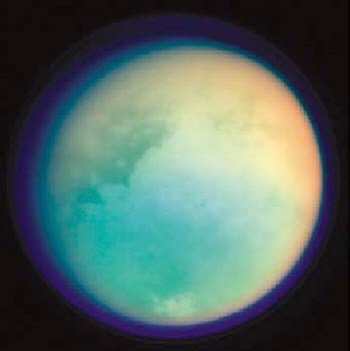Europe's Huygens probe has made the first direct study of Saturn's largest moon Titan and its atmosphere. The probe landed on Titan in January after being released from its parent Cassini spacecraft on Christmas day 2004. The new data -- published by seven international research teams in Nature this week -- could lead to a better understanding of the frozen conditions that existed on the Earth when it was young.

Titan lies ten times further away from the Sun than Earth and has never been studied directly. Previous missions like the fly-by Voyager spacecraft in 1980 and 1981 were unable to penetrate through the thick organic haze surrounding the moon. Earlier this year, the Cassini mission took remote images of Titan while orbiting Saturn using various onboard instruments. But the Huygens probe has now made the first in-situ study of the moon’s atmosphere and surface using six different instruments.
Titan’s atmosphere is mainly nitrogen, along with small amounts of organic material such as methane. The pressure at the surface is about 1.5 atmospheres, which is quite similar to the Earth, but the temperature is only about 90 K according to measurements made with the Huygens Atmospheric Structure Instrument (Nature 438 800). At such low temperatures, the methane in Titan’s atmosphere could play a similar role to the water in Earth’s atmosphere.
The aerosols that make up Titan’s clouds have solid cores consisting of organic molecules containing carbon and nitrogen, according to data from another Huygens instrument — the Aerosol Collector and Pyrolyser (Nature 438 796). It captured and heated aerosols in Titan’s atmosphere when the probe descended onto the moon’s surface. These aerosols were then sent to a Gas Chromatograph Mass Spectrometer, which found the presence of nitrogen-containing organic compounds that steadily fall onto Titan’s surface as rain (Nature 438 779). The results also suggest that the nitrogen originally arrived on Titan as a mixture of compounds, such as ammonia, and then broke down into molecular nitrogen – like on Earth.
A further three papers describe various other characteristics of Titan. These include measurements of its winds, which blow in the same direction as the moon rotates and have speeds of about 1 metre per second. The Descent Imager/Spectral Radiometer (DISR) showed that Titan’s landscape resembles that of Earth’s except that features, like dry riverbeds, have been forged from liquid methane and not water. Finally, the surface of Titan has been found to have the consistency of wet sand but is made up of condensed methane, ice and aerosols.




